函数
1.1 数值型函数
-- 数值型函数
-- 四舍五入round(x,y)对x保留y为小数
select round(23.652) from dual;
select round(23.652,1) from dual;
select round(25.652,-1) from dual;
-- 返回x按精度y截取后的值
select trunc(23.652) from dual;
select trunc(23.652,2) from dual;
select trunc(23.652,-1) from dual;
-- mod(x,y)求余数
select mod(9,2) from dual;
-- ceil 向上取整
select ceil(1.9) from dual;
-- floor 向下取整
select floor(1.9) from dual;
1.2 日期函数
-- 返回系统当前时间
select sysdate from dual;
-- 返回当前会话时区中的当前日期
select current_date from dual;
-- 添加月数
select add_months(sysdate,1) from dual;
-- 返回两个时间相差的月数
select months_between(sysdate,add_months(sysdate,2)) from dual;
-- 需求:查询工作年限在30年以上
select e.ename,e.hiredate
from emp e
where months_between(sysdate,e.hiredate)/12 > 30
-- 返回date所在月份最后的一天
select last_day(add_months(sysdate,1)) from dual;
-- next_day(date1,week) 返回date1下周星期几的日期
select sysdate "当时日期",next_day(sysdate,'Monday') "下周星期一" from dual;
-- 查询会话的环境参数
select * from nls_session_parameters;
1.2.1 日期函数相关计算
两个时间进行四则运算的单位是天。
select sysdate+2 from dual;
select sysdate-2 from dual;
1.3 转换函数
转换函数就是把字符、日期、数值型数据进行相互转换。类型转换分两种:隐式类型转换和显式类型转换
1.3.1 隐式类型转换
字符和数字/日期之间的隐式转换
-- 字符隐式转换成数值
select '100' - 10 from dual;
-- 字符隐式转化为日期
-- DD-MON-RR 默认的日期格式
select 1 from dual
where sysdate > '13-May-19';
--查date format格式
select * from nls_session_parameters;
1.3.2 显示类型转换
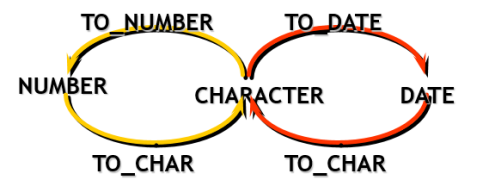
1.3.3 to_char(A)
把日期转化成字符
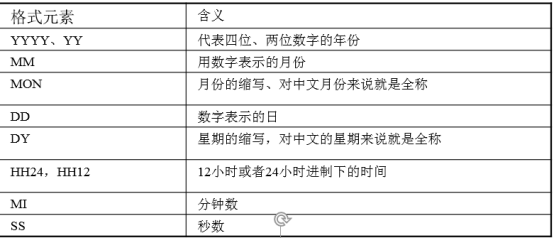
把数值格式化成字符串
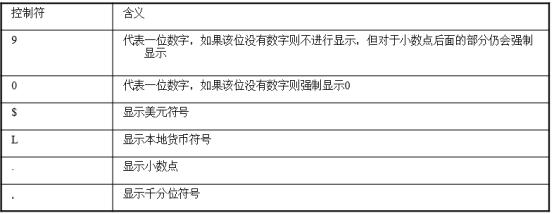
-- to_char
-- 【1】把日期转化成字符
-- 按照默认格式DD-MON-RR
select to_char(sysdate) from dual;
-- 按指定格式
select to_char(sysdate,'YYYY"年"MM"月"DD"日" HH24:MI:SS') as t from dual;
-- 【2】把数值格式化成字符串
select to_char(12345,'99999.99') from dual;
select to_char(12345,'99,999.99') from dual;
select to_char(12345,'999,999.99') from dual;
-- 不够位置0
select to_char(12345,'000,000.00') from dual;
-- 格式化成美元显示
select to_char(12345,'$000,000.00') from dual;
-- 需求:把18612341234格式化成186-1234-1234
select replace(to_char(18612341234,'999,9999,9999'),',','-') from dual;
1.3.4 to_number、to_date(A)
-- to_number
select to_number('$12,345','$99,999') from dual;
select to_number('$12,345.12','$99,999.99') from dual;
-- to_date
select to_date('14-May-19','DD-MON-RR') from dual;
select to_date('2004-09-19','YYYY-MM-DD') from dual;
函数可以嵌套
-- 查询雇用期满6个月的下一个周一的日期。
select e.ename,e.hiredate,next_day(add_months(e.hiredate,6),'Monday')
from emp e
where months_between(sysdate,e.hiredate) > 6
-- 查询公司boss
select e.ename || nvl(to_char(e.mgr),' is boss')
from emp e
where e.mgr is null
1.4 decode/case when(A)
decode(条件,值1,“返回值1”, 值2,“返回值2”,,,“默认值”)
-- 需求:查询员工所在的部门名称
select
e.ename,
e.deptno,
decode(e.deptno,10,'部门1',20,'部门2',30,'部门3','未知')
from emp e;

case when
|
-- case when select e.ename, e.deptno, case e.deptno when 10 then '部门1' when 20 then '部门2' when 30 then '部门3' else '未知' end from emp e; |
|
-- 需求:对各个部门进行涨薪,10->1.1 20->1.2 30->1.3 其他->1.0 select e.deptno, e.ename, e.sal "涨薪前", decode(e.deptno,10,e.sal*1.1,20,e.sal*1.2,30,e.sal*1.3,e.sal) "涨薪后" from emp e
-- 需求:根据工资分布输出以下信息 /* <1000 真屌丝 (1001,2000] 屌丝 (2001,3000] 白领 (3001,5000] 高富帅 (5001,10000] 土豪 */
select e.ename "姓名", e.sal "工资", case when e.sal <= 1000 then '真屌丝' when e.sal <= 2000 then '屌丝' when e.sal <= 3000 then '白领' when e.sal <= 5000 then '高富帅' when e.sal <= 10000 then '土豪' else '未知' end "描述" from emp e; |
decode 多用于等值匹配;case when可以用于等值,多用于条件分支。
2.1 组函数(A)
组函数把多行数据经过运算后返回单个值。也称聚合函数。
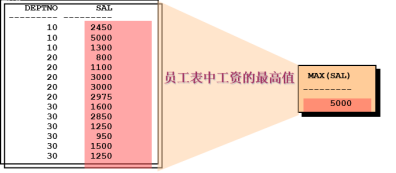
-- 求公司雇员的数量
select count(*)
from emp e;
select count(e.empno)
from emp e;
select count(1)
from emp e;
-- avg:对多个记录的某个字段求平均值
-- 需求:求底薪的平均值
select avg(e.sal)
from emp e;
-- 需求:求雇员的最高薪资/最低薪资
select max(e.sal),min(e.sal),avg(e.sal)
from emp e;
-- 需求:求公司一个月的员工基本开销
select sum(e.sal)
from emp e;
注意:
[1] 组函数或聚合函数是对一个数据集(表数据、查询出来的表、分组的表)进行聚合。
[2] 聚合函数对字段是null的值进行忽略。count(*)
- 求有津贴的员工的数量
select count(e.comm)
from emp e;
max/min 适合任意数据类型,sum/avg 只适用于数值类型。
聚合函数的结果可以作为其他查询条件。
-- 最早入职的员工
select e.ename,e.hiredate
from emp e
where e.hiredate = (select min(e.hiredate) from emp e);
2.2 分组(group by)(A)
在处理统计或聚合数据时,很多时候需要对数据进行分组 语法
|
select field1,。。。 from tableName group by field1[,field2,…] |
按照field1[,field2,…] 分组,字段值相同的记录分到一组。
1.2.1 group by的工作原理
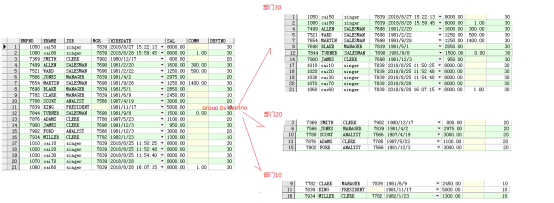
对数据进行分组后,select语句的字段值只能是分组字段或者聚合函数。
1.2.2 [1]分组和聚合函数
-- 需求:求各个部门的人数
select e.deptno,e.ename
from emp e
group by e.deptno;
-- 需求:统计部门10的人数
select count(1)
from emp e
where e.deptno = 10;
-- 需求:求各个部门的人数
select e.deptno,e.ename
from emp e
group by e.deptno;
-- 需求:求各个部门的平均薪资
select e.deptno,avg(e.sal)
from emp e
group by e.deptno
-- 需求:求各个部门的月收入平均值
select e.deptno,avg(e.sal+nvl(e.comm,0))
from emp e
group by e.deptno
null值归为一组
-- 特例:按照津贴分组
select e.comm,count(1)
from emp e
group by e.comm

1.2.3 having
如果需要对分组的数据进行条件过滤,必须使用having!!!
-- group by having
-- 查询部门平均薪资大于3000的部门
select e.deptno
from emp e
group by e.deptno
having avg(e.sal) > 3000
-- 查询部门薪资大于3000的雇员按部门分组的平均薪资
select e.deptno,avg(e.sal)
from emp e
where e.sal > 3000
group by e.deptno;
注意:
[1] Where过滤行,having过滤分组。
[2] Having支持所有where操作符。
3.1 排序 (order by)(A)
当需要对数据集进行排序操作时,语法
|
select field1, field2,。。。 from tablename order by field1,field2 |
对数据集进行排序,先按field1排序,如果field1排序相同,按照field2排序,依次类推。
-asc 升序,默认
-desc 降序
-- order by
-- 需求:按雇员薪资排序
select e.ename,e.sal
from emp e
order by e.sal desc
-- 按薪资升序,名称降序
select e.ename,e.sal
from emp e
order by e.sal,e.ename desc;
order by 一般都是最后执行。
查询 薪资大于1200的雇员所在部门的平均薪资大于1500的部门,按照平均薪资升序排序。
-- [1] 查询薪资大于1200的雇员
select e.*
from emp e
where e.sal > 1200
-- [2]按部门分组
select e.*
from emp e
where e.sal > 1200
group by e.deptno
-- [3] 输出聚合结果
select e.deptno,avg(e.sal)
from emp e
where e.sal > 1200
group by e.deptno
having avg(e.sal) > 1500
-- [4]对数据集进行排序
select e.deptno,avg(e.sal)
from emp e
where e.sal > 1200
group by e.deptno
having avg(e.sal) > 1500
order by avg(e.sal) asc
order by 既可以用于数据行(记录)排序。
也可以对分组的结果进行排序,此时需要聚合函数配合。
3.2 Select 语言的执行顺序 (B)
- 读取from子句中的基本表、视图的数据,[执行笛卡尔积操作]。
- 选取满足where子句中给出的条件表达式的元组
- 按group子句中指定列的值分组,同时提取满足Having子句中组条件表达式的那些组
- 按select子句中给出的列名或列表达式求值输出
- Order by子句对输出的目标表进行排序。
from -> where -> group by -> having -> select -> order by
4.1 交集、全集、并集、差集(C)
并集:把集合A的结果和集合B的结果合并,并去掉重复的记录。
-- 并集
select e.* from emp e where e.deptno = 10
union
select e.* from emp e where e.deptno = 20;
-- 有重复记录取并集
select e.* from emp e where e.deptno = 10 or e.deptno = 20
union
select e.* from emp e where e.deptno = 20;
全集: 把集合A的结果和集合B的结果合并,保留重复记录
select e.* from emp e where e.deptno = 10 or e.deptno = 20
union all
select e.* from emp e where e.deptno = 20;
交集: 把集合A的结果和集合B的结果取相同部门
select e.* from emp e where e.deptno = 10 or e.deptno = 20
intersect
select e.* from emp e where e.deptno = 10;
差集: 在集合A的结果中去掉集合B的结果 (A-B)
select e.* from emp e where e.deptno = 10 or e.deptno = 20
minus
select e.* from emp e where e.deptno = 10;
4.2 多表关联(A)
笛卡尔积(C)

-- 笛卡尔积
select *
from emp,dept
4.1 等值连接
-- 等值连接
-- 需求:查询雇员的部门名称
select e.ename,e.deptno,d.dname
from emp e,dept d
where e.deptno = d.deptno
4.2 不等值连接
-- 不等值连接
-- 查询每个雇员的薪资等级
select e.ename,e.sal,sg.grade
from emp e,salgrade sg
where e.sal >= sg.losal and e.sal <= sg.hisal
4.3 外连接(B)
左外连接:左边的表作为主表,右边表作为从表,主表数据都显示,从表数据没有,用null填充,用+号表示。
-- 左外连接(B)
-- 需求:查询所有部门的雇员
select *
from dept d,emp e
where d.deptno = e.deptno(+)
右外连接: 右边的表作为主表,左边表作为从表,主表数据都显示,从表数据没有,用null填充,用+号表示。
-- 右外连接(B)
select *
from emp e,dept d
where e.deptno(+) = d.deptno;
4.4 自连接
一个表自身连接自身时,称为自连接。自连接以不同的视角看待同一张表。
-- 查询每个雇员的上级领导
select e.ename "雇员",m.ename "领导"
from emp e,emp m
where e.mgr = m.empno
-- 优化king
select e.ename "雇员",nvl(m.ename,'boss') "领导"
from emp e,emp m
where e.mgr = m.empno(+)



